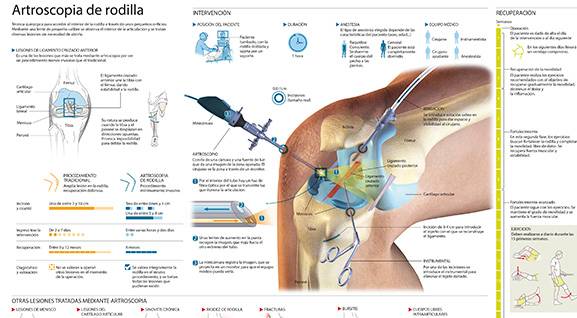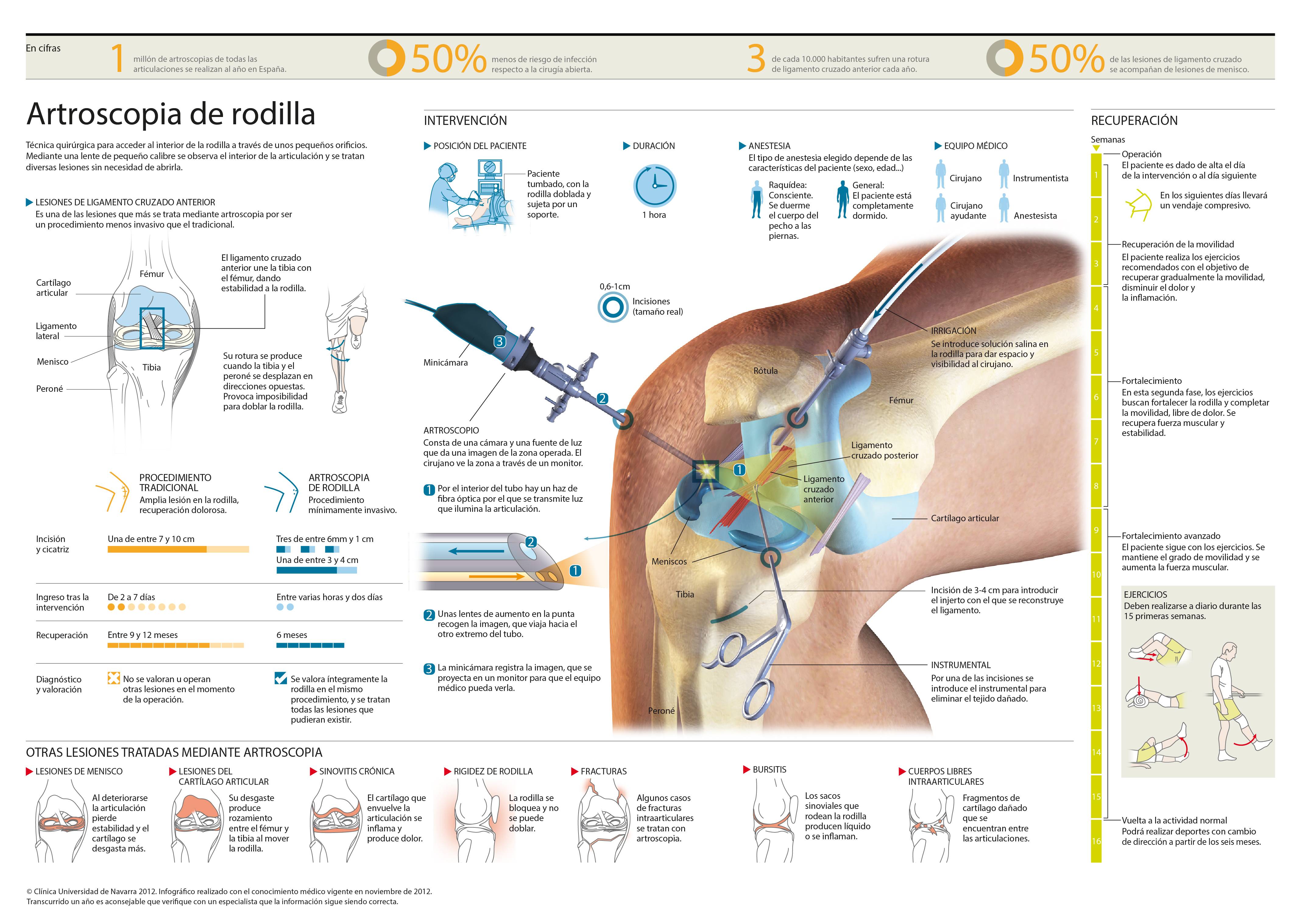Knee Arthroscopy
"In young, active and habitual sportsmen, the surgical treatment by means of arthroscopy is the definitive solution".
DR. ANDRÉS VALENTÍ SPECIALIST. ORTHOPEDIC SURGERY AND TRAUMATOLOGY DEPARTMENT

What is knee arthroscopy?
Knee arthroscopy is a surgical procedure that allows us to observe the knee joint through small incisions through the skin. Arthroscopy is used to diagnose and treat a wide range of knee problems.
During knee arthroscopy, your surgeon inserts a small camera, called an arthroscope, into the joint and displays images that will guide the surgical instruments.
Among the advantages of arthroscopy, there is a rapid recovery due to less aggressive surgery, less pain, faster functional recovery and shorter hospital or outpatient stays.

When is knee arthroscopy indicated?
There is an increasing number of interventions that can be performed by arthroscopy, with great advantages over classic (open) surgery.
By means of knee arthroscopy, nowadays, it is possible to repair and treat cartilage problems, meniscal injuries, ligament reconstructions, free body extraction, synovial or articular tissue cleaning among other procedures...
The advantages of the endoscopic technique over classic surgery are faster patient recovery and less post-operative discomfort, since it is a less invasive operation.
In order to achieve complete recovery of the joint after an arthroscopy, it is convenient for the patient to perform rehabilitation exercises that will help the healing of the tissues and a complete recovery.
Most frequent indications for knee arthroscopy
- Ligament injuries
- Meniscus injuries
- Lesions of the articular cartilage
- Chronic synovitis
- Stiffness of the joint
- Fractures
- Bursitis
- Intra-articular free bodies.
Do you have any of these diseases?
You may need to have knee arthroscopy
How is knee arthroscopy performed?
Knee arthroscopy surgery
To perform this technique, the arthroscopist uses specially designed video cameras and small lenses (1.9 mm to 4 mm), and small-caliber instruments that can be inserted into the joints without damaging them (forceps, scissors, etc.).
Before your surgery, a member of the anesthesia team will discuss with you the types of anesthesia and their recommendations. Knee arthroscopy can be performed under either loco-regional or general anesthesia.
The complication rate after arthroscopic surgery is usually very low. If complications do occur, they are usually minor and easily treated. The possible postoperative problems with knee arthroscopy include: stiffness of the knee, local discomfort and as all surgery there is a risk of thrombosis and infection (lower than in other types of interventions)
While recovery from knee arthroscopy is faster than recovery from traditional open knee surgery, it is important that you follow your doctor's instructions carefully when you return home.
Care after knee arthroscopy
A bandage will be made to protect the incisions and perform a gentle compression. The duration of the surgery will depend on the findings and the necessary treatment.
After surgery, you will be taken to the recovery room and can return home in a few hours if it is an outpatient procedure or you will be admitted to a room for one night if your surgeon so indicates.
You will have to perform the recommended exercises with the objective of gradually regaining mobility, decreasing pain and inflammation.
Recovery after knee arthroscopy
Many people return to full, unrestricted activities after arthroscopy. Your recovery will depend on the type of pathology that was present in your knee.
Except for ligament reconstruction, or cartilage pathology, you should be able to return to most physical activities after 3-4 weeks, or sometimes much sooner.
Higher impact activities or if your job involves heavy work, it may take longer before you can return to work. Discuss when you can safely return to work with your doctor.
Sometimes, the damage to your knee may be severe enough that it cannot be completely reversed with surgery.
Your surgeon will tell you when it is safe to put weight on your foot and leg.
You should exercise your knee regularly for several weeks after surgery. This will restore movement and strengthen your leg and knee muscles. Working with a physical therapist can help you achieve your best recovery. A formal physical therapy program can improve your end result.
Where do we do it?
IN NAVARRE AND MADRID
The Department of Orthopedic Surgery and Traumatology
of the Clínica Universidad de Navarra
The Department of Orthopedic Surgery and Traumatology covers the full spectrum of congenital or acquired conditions of the musculoskeletal system including trauma and its aftermath.
Since 1986, the Clinica Universidad de Navarra has had an excellent bank of osteotendinous tissue for bone grafting and offers the best therapeutic alternatives.
Organized in care units
- Hip and knee.
- Spine.
- Upper extremity.
- Pediatric orthopedics.
- Ankle and foot.
- Musculoskeletal tumors.

Why at the Clinica?
- Experts in arthroscopic surgery.
- Highly qualified professionals who perform pioneering techniques to solve traumatological injuries.
- One of the centers with the most experience in bone tumors.






















